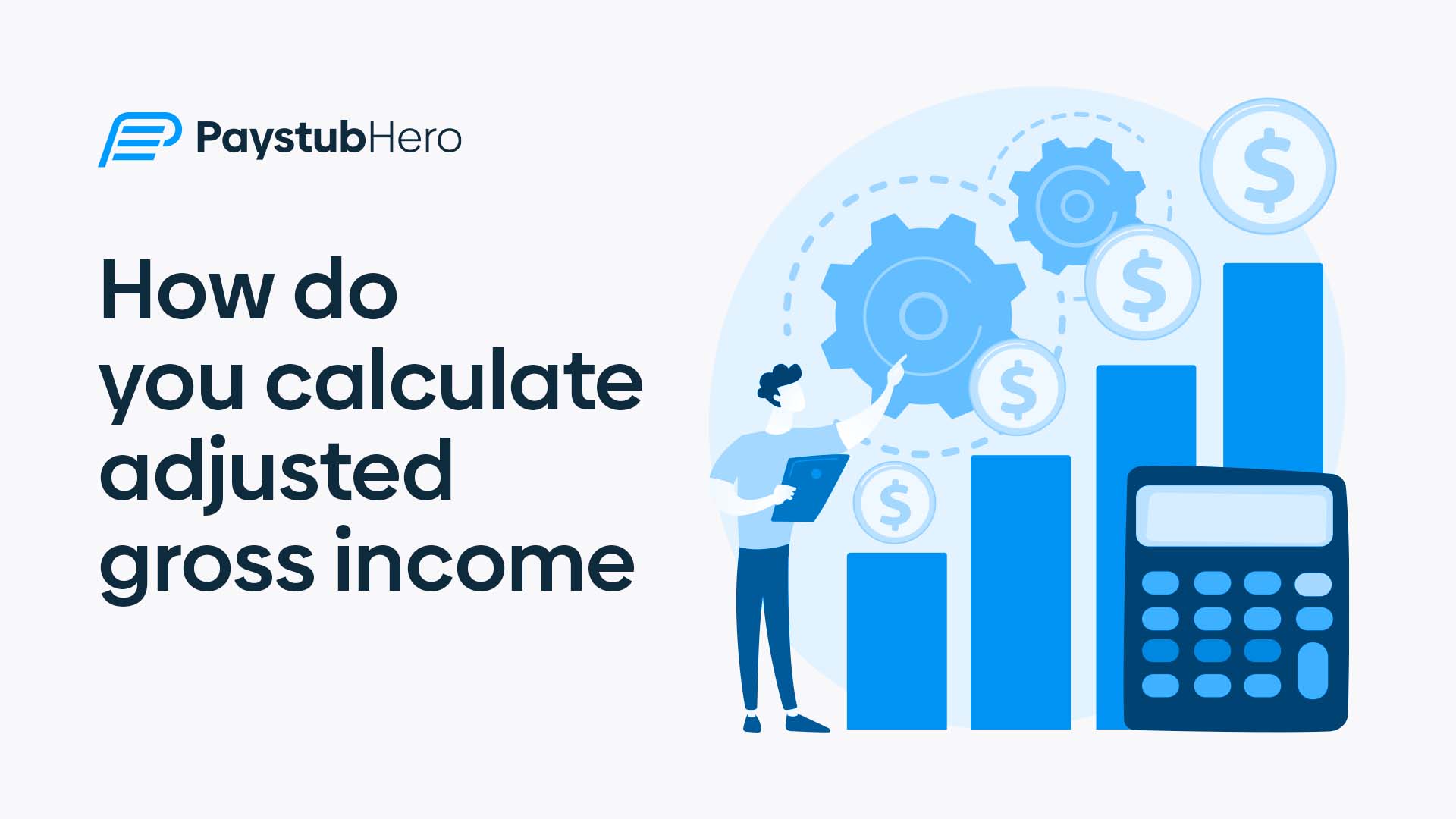Let’s start by acknowledging the elephant in the room – finances can be complex. When it comes to comprehending our paycheck or income statement, it feels like we need a decoder ring to decipher the many lines, acronyms, and numbers.
Whether you’re an entrepreneur, freelancer, or an employee, one term that often leaves you scratching your head is ‘adjusted gross income’ (AGI).
Indeed, understanding the jargon and crunching the numbers is not everyone’s cup of tea. More so, when these figures play a vital role in our financial planning, savings, and taxation.
Therefore, having a clear understanding of these financial metrics can help us make informed decisions, simplify our tax filing process, and manage our personal finances more effectively.
So, how do you calculate adjusted gross income? The answer is simpler than you might think. Your adjusted gross income (AGI) is essentially your gross income, subtracting certain allowable deductions.
As straightforward as it sounds, it’s important to comprehend each element involved in this calculation to ensure you’re getting the numbers right.
In the upcoming sections, we’ll explore the underlying concepts of gross income, the distinction between net and gross income, and walk you through a step-by-step process to calculate your AGI.
Not just that, we’ll also provide insights on the significance of AGI and how it affects various aspects of your financial life.
So, let’s dive in and unravel these financial metrics, one step at a time.
Table of Contents:
- Introduction: Understanding the Intricacies of Your Income
- Understanding Gross Income: The Foundation of Your Finances
- Net vs Gross: Unraveling the Crucial Differences in Your Income Statements
- Calculating Your Adjusted Gross Income: An In-Depth, Practical Approach
- The Importance of Knowing Your Adjusted Gross Income: More than Just a Number
- Take Control of Your Income with Paystubhero: Simplifying Finance for Entrepreneurs and Freelancers
Understanding Gross Income: The Foundation of Your Finances
Now that we’ve set the stage, let’s delve deeper into the concept of gross income. When you hear the term ‘income,’ the chances are high that the figure you’re thinking of is your gross income.
It’s that big, impressive number on your salary agreement or the yearly figure you aim for when planning your finances. But what does it truly represent?
Gross income, in its simplest form, is the total income you earn in a year before any deductions or taxes are taken out. It’s an umbrella term that includes all income sources, be it your wages, interest accrued on your savings, dividends from any investments, rental and royalty income, profits from selling assets (capital gains), or income from a business venture if you’re an entrepreneur.
In essence, if it’s money coming into your pocket over a fiscal year, it likely counts towards your gross income.
However, your gross income doesn’t always provide the complete picture of your financial position. It is a pre-deduction figure, which means it doesn’t take into account any expenses, allowances, or tax deductions you may have over the year.
These deductions can significantly lower the amount of income that is subject to taxes, making it a critical aspect to consider. That’s where concepts like net income and adjusted gross income come into play, helping provide a more holistic view of your financial standing.
In the following sections, we’ll explore these metrics and the crucial differences that distinguish them, providing you with a comprehensive understanding and a clear roadmap for calculating your adjusted gross income.
Net vs Gross: Unraveling the Crucial Differences in Your Income Statements
Now that we have a clear understanding of gross income, let’s turn our attention to another equally important but often misunderstood term – net income.
To appreciate the full spectrum of your finances, understanding the differences between net and gross income is paramount.
In everyday terms, net income is what most people refer to as their ‘take-home pay’. It’s the money that lands in your bank account after all deductions, such as taxes, social security, retirement contributions, health insurance, and other deductions, have been subtracted from your gross income. This distinction gives rise to the concept of gross vs net income.
The fundamental difference between gross and net income rests in the element of deductions. Gross income represents your income before any deductions or taxes, providing a broad view of your earnings.
However, it may overstate your actual financial capacity since it doesn’t account for the various deductions that lower your income.
On the other hand, net income provides a more realistic perspective on your finances. It reflects your actual spending power by considering all the expenses and deductions applicable to your income.
Knowing your net income is crucial as it helps you understand how much money you truly have to allocate towards savings, investments, and daily expenses.
However, the story doesn’t end here. In the realm of personal finance and taxation, another key player comes into the picture: adjusted gross income.
AGI is a more refined metric that combines elements of both gross and net income, providing an important basis for tax calculations and financial planning.
In the next section, we’ll dive into the intricacies of calculating your adjusted gross income, providing you with a practical guide and actionable steps to help you navigate this essential financial task.
Calculating Your Adjusted Gross Income: An In-Depth, Practical Approach
After understanding the fundamentals of gross and net income, we’re now ready to take the leap into the territory of adjusted gross income (AGI).
One might ask, how do you calculate gross adjusted income? It’s a straightforward process that involves starting with your gross income and subtracting specific, IRS-approved deductions.
However, this summary doesn’t capture the whole picture. To successfully calculate your AGI, it’s essential to understand each component of this process in detail. So let’s break it down step by step.
Step 1: Calculating Your Gross Income
The journey to determining your AGI starts with figuring out your gross income. This involves adding all your sources of income for the year. Income sources can include wages from your job, earnings from a side hustle, dividends from your investments, rental income, and any other cash inflow. Remember, gross income doesn’t discriminate between income sources; if it’s money that you’ve earned within a fiscal year, it should be counted towards your gross income.
Step 2: Identifying Your Deductions
The second step towards calculating your AGI involves identifying the deductions applicable to your situation. This can be a bit tricky, as not all expenses can be deducted from your gross income.
The IRS provides a list of approved deductions, which include certain business expenses for self-employed individuals, student loan interest, alimony payments made under a pre-2019 divorce agreement, and more.
It’s important to keep track of these expenses throughout the year, as they can significantly lower your AGI and, consequently, your tax liability.
Step 3: Subtracting Your Deductions from Your Gross Income
Finally, once you’ve calculated your gross income and identified your deductions, it’s time to subtract your deductions from your gross income. The result is your adjusted gross income.
Let’s consider an example to illustrate this. Suppose you earned $60,000 this year and you have $10,000 in applicable deductions. To calculate your AGI, you’d subtract your deductions from your gross income. So, your AGI would be $50,000 ($60,000 – $10,000).
While this might seem daunting, it’s important to remember that understanding your AGI is a fundamental aspect of personal finance. Knowing this number not only helps streamline your tax preparation process, but it also plays a critical role in other areas of financial planning and decision making.
In the following sections, we’ll delve into the importance of AGI and how our decisions today can impact this crucial financial figure.
The Importance of Knowing Your Adjusted Gross Income: More than Just a Number
Having a comprehensive understanding of your adjusted gross income is not just an intellectual exercise or a prerequisite for tax season. AGI plays a central role in your personal finances, influencing various aspects from taxation to financial planning. So, let’s delve into why knowing your AGI matters.
Firstly, AGI serves as the foundation for your tax calculations. The IRS uses your AGI as a starting point to determine how much of your income is taxable. Knowing your AGI can help you forecast your potential tax liability, allowing you to plan accordingly and avoid any unpleasant surprises at tax time.
Moreover, AGI is crucial in determining your eligibility for several tax credits and deductions. Many of these credits, like the earned income tax credit and the child tax credit, are income-dependent. If your AGI is below certain thresholds, you may qualify for these valuable tax benefits. This underscores the importance of accurately calculating and understanding your AGI.
Beyond taxes, AGI plays a crucial role in other areas of your financial life. When applying for loans or mortgages, lenders often examine your AGI to assess your repayment capacity.
A higher AGI might signal to lenders that you’re a lower credit risk, potentially helping you secure a loan with more favorable terms.
Additionally, understanding your AGI can also aid in financial planning. It offers a realistic picture of your income, which is essential when budgeting, planning for retirement, or setting savings goals.
By knowing your AGI, you can create a financial plan that aligns with your actual income, enhancing the likelihood of achieving your financial goals.
In the final section of this article, we’ll discuss how you can simplify the process of calculating and understanding your AGI with the help of modern financial tools.
We’ll introduce you to Paystubhero, an online payroll software designed to help entrepreneurs, freelancers, small businesses, and independent contractors manage their income calculations effortlessly.
Take Control of Your Income with Paystubhero: Simplifying Finance for Entrepreneurs and Freelancers
While we’ve delved into the intricacies of calculating adjusted gross income and underscored its significance, we understand that managing income and payroll can still be a complex task, especially for entrepreneurs, freelancers, and small businesses.
This is where Paystubhero comes into the picture, striving to simplify the process and offer a reliable, user-friendly solution.
Paystubhero is an online payroll software designed to serve as your financial ally. We’re here to help you navigate the labyrinth of income calculations without the need for advanced accounting skills or the hefty price tag of traditional payroll services.
Our goal at Paystubhero is to provide a streamlined, robust solution that helps solo-entrepreneurs and small businesses generate their financial documents quickly, efficiently, and without the hassles that usually come with the territory.
All you have to do is enter your company and employee information, and our software takes care of the rest, handling all the calculations seamlessly.
With Paystubhero, you can effortlessly keep track of your gross income, net income, and yes, even your adjusted gross income. No more grappling with complicated formulas or tax tables.
Our platform takes care of the heavy lifting, allowing you to focus on what truly matters – growing your business and achieving your financial goals.
Moreover, the knowledge and clarity you gain about your income through Paystubhero can also empower you to make better financial decisions, plan your taxes effectively, and understand the financial health of your business.
So why wait? It’s as easy as 1-2-3. Take control of your finances with Paystubhero today. Empower yourself with the right financial tools and witness the transformative impact on your business and personal financial journey.
Frequent Asked Question
- How do I find my adjusted gross income on my W2?
- Your W-2 form doesn’t directly show your adjusted gross income (AGI). Instead, it lists your gross income. To find your AGI, you’ll need to subtract eligible deductions from your gross income.
- What reduces your adjusted gross income?
- Several items can reduce your AGI, including contributions to a traditional IRA, student loan interest, alimony payments made under a pre-2019 divorce agreement, and certain business expenses for the self-employed.
- Is adjusted gross income the same as net income?
- No, adjusted gross income and net income are not the same. AGI is your gross income minus specific IRS-approved deductions. Net income, on the other hand, is your income after all taxes and other deductions have been taken out.
- What is 7.5% of your adjusted gross income?
- To calculate 7.5% of your AGI, multiply your AGI by 0.075. This figure is often used as a threshold for certain medical expense deductions.





